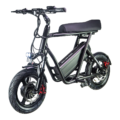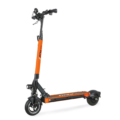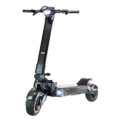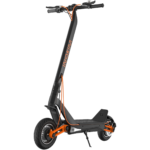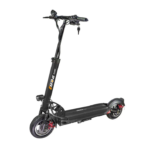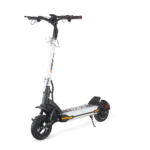- Home
- Scooters
- Electric Scooters
- EMOVE Cruiser V2
EMOVE Cruiser V2
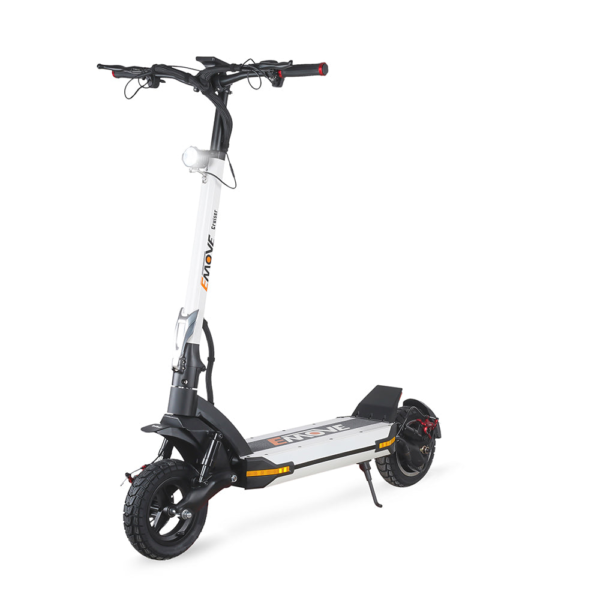

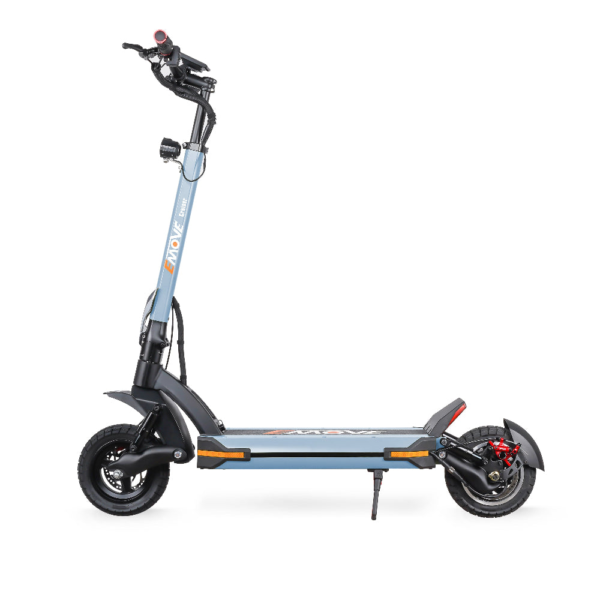
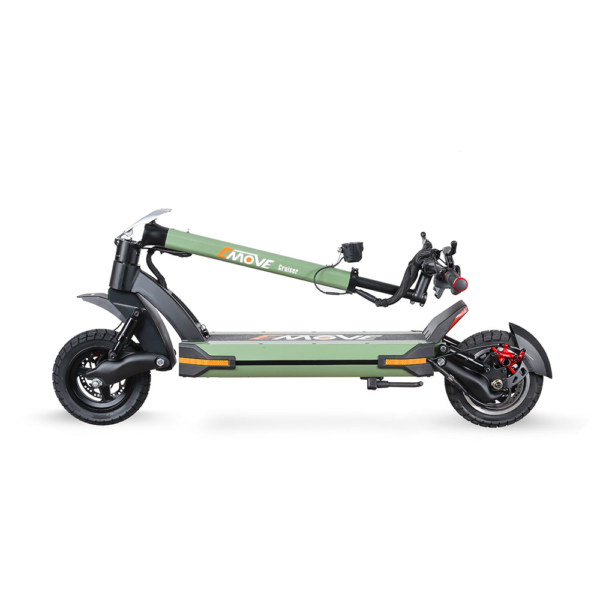
- Battery Range: 62 miles (100 km)
- Top Speed: 33 mph (53.1 km/h)
- Motor Power: 1000 W
- Weight Capacity: 330 lb (150 kg)
- Charging Time: ~9–12 h
- Scooter Weight: 74.0 lb (33.6 kg)
PROS
- Quad spring suspension improves comfort
- 52V 30Ah LG 21700 battery (1,560 Wh)
- IPX6 water resistance
- XTECH hybrid hydraulic disc brakes
- 3.5″ LCD display with signals
CONS
- Heavier at 74 lb
- No Bluetooth app
- Dimensions not specified officially
- Long charge time (9–12 h)
Key Takeaways
- The EMOVE Cruiser V2 features a powerful 52-volt battery and a strong rear hub motor for impressive range and stability.
- With a top speed of about 33 mph (53 km/h), this single-motor scooter suits urban commuting and handles various terrains.
- Dual hydraulic brakes, IPX6 water resistance, and 10-inch tubeless tires enhance safety and comfort in different weather conditions.
- Users report a range of 35 to 50 miles (56 to 80 km) in mixed city rides, making it ideal for daily commutes and longer journeys.
- Suitable for riders up to 352 lb (160 kg), the EMOVE Cruiser V2 excels in durability and performance for city travel.
Table of contents
- What Is the EMOVE Cruiser V2?
- How the EMOVE Cruiser V2 Works
- Key Specifications
- Design & Build Quality
- Performance Fundamentals
- Battery, Range & Efficiency
- Ride Quality & Comfort
- Braking & Safety Features
- Portability & Daily Usability
- Maintenance & Care
- Weather & Seasonal Considerations
- EMOVE Cruiser V2 vs Alternatives
- Who the EMOVE Cruiser V2 Is (and Isn’t) For
- FAQs
- Glossary
The EMOVE Cruiser V2 is for riders who want real range without drama. It packs a big 52-volt battery, a strong rear hub motor, and hydraulic brakes that just work. You get steady handling, rain confidence, and an easy cockpit. And yes, it’s built to take daily miles.
This version keeps the facts and loosens the voice. You’ll see simple sentences, plain tips, and the key specifications in both imperial and metric units.
What Is the EMOVE Cruiser V2?
The EMOVE Cruiser V2 is a single-motor scooter made for pavement, bike lanes, and city riding. It favors range and stability over flashy numbers. It runs a 52V system with a 30Ah pack, a rear hub motor around 1,000W nominal, and a sine-wave controller that feeds smooth, quiet power. Top speed lands near 33 mph (53 km/h), which is quick for city runs without feeling sketchy.
The frame feels stout. It supports riders up to 352 lb (160 kg), so daily bags and gear are not a problem. The deck is long and grippy, so your stance stays natural with room to shift. The stem folds and locks with a safety catch. Dual spring suspension takes the edge off rough blocks, and 10-inch tubeless pneumatic tires bring grip and comfort.
You get hydraulic discs front and rear, bright lights, and usable turn signals. The IPX6 rating handles heavy splashes and rain. So the whole package leans toward safe, confident commuting in real weather.
How the EMOVE Cruiser V2 Works
Think of a simple chain of parts working together. Each piece has a job, and the result is smooth motion you can trust.
- Motor. The rear hub pushes. Rear drive helps on grit and painted lines. Power ramps in cleanly, not like a light switch.
- Controller. The sine-wave controller meters current from your thumb. Starts feel tidy, and cruising stays quiet. So low-speed control is easy in crowds.
- Battery. A 52V, 30Ah pack stores roughly 1.56 kWh. The BMS guards the pack, balances cells, and blocks bad charge or discharge events.
- Throttle. The right-side thumb throttle gives fine control. Small inputs equal small changes. Then cruise control can hold a steady pace on flat ground.
- Brakes. Dual hydraulic discs deliver real stopping power with light lever effort. Electronic regen adds gentle drag when you roll off, which trims speed and pad wear.
So you press the throttle, the controller feeds the hub, and the scooter glides up to speed. Then you back off and regen starts the slowdown, with the discs finishing the job.
Key Specifications
Here are the specifications you’ll want to scan first. Values are listed in both imperial and metric units.
| Block | Details |
|---|---|
| General | Single-motor urban scooter • Rear-wheel drive • 10-inch tubeless pneumatic tires • Dual spring suspension • Foldable stem and bars • High water resistance (IPX6) |
| Performance & Power | Top speed: ~33 mph (53 km/h) • Motor: rear hub, ~1,000W nominal (≈1,600W peak) • Controller: sine-wave, ~25A • Max rider load: 352 lb (160 kg) |
| Battery, Charging & Electrical | Battery: 52V 30Ah (≈1,560 Wh) • Standard charger: ~2A at 58.8V • Dual charge ports supported • Single-charger time: ~9–12 hours • Optional fast charging available • Electronic regen: adjustable |
| Build & Dimensions | Weight: ~59 lb (26.8 kg) • Tires: 10 × 2.75 in (25.4 × 7.0 cm), tubeless pneumatic • Deck: long, grippy surface with roomy stance • Folded dimensions: ~49 × 10 × 19 in (124.5 × 25.4 × 48.3 cm) |
| Safety & Control | Brakes: dual hydraulic discs • Headlight, tail and brake light, turn signals, side reflectors • Loud horn • Strong stem latch with safety catch |
| Features & Extras | Thumb throttle • Cruise control • Color display for speed, battery, trip, and mode • Ride modes • Kickstand • Front and rear fenders |
| Warranty & Compliance | Limited 1-year warranty (terms vary by region) • IPX6 water resistance • Reflectors that fit many city rules |
So you can skim this table before a test ride. And you can come back later during setup to match the specifications in the display.
Design & Build Quality
The Cruiser V2 feels solid in the hand and on the road. The stem uses a chunky latch plus a backup catch, so it stays quiet over bumps. The hinge resists the kind of flex you feel on lighter stems. You notice that stiffness when you brake hard or lean through a turn. The deck wears coarse-grit grip that holds wet or dry shoes. Edges are clean, and the wiring has strain relief where it needs it.
The cockpit keeps things tidy. Levers feel firm and keep their bite point. The thumb throttle has a short, smooth throw. The display reads well in sunlight. At night, the headlight throws a flat beam that lights a lane without glare. The tail brightens when you brake, and the signals are easy to reach.
Panels and fenders sit tighter than budget stuff. You can lift by the deck or near the stem without creaks. Hardware uses common hex bolts. Tubeless rims seat beads well, which cuts pinch flats and holds pressure longer than tubes. Fit and finish land above a basic commuter tier, and the scooter still feels tight after months of daily use.
Performance Fundamentals
The EMOVE Cruiser V2 leaves the line with a calm surge. It does not jump, and it is not lazy. The sine-wave controller smooths the climb from walking pace to city speed. So you can feed in throttle mid-turn without a snap that unsettles the chassis. New riders relax fast. Experienced riders stay quick without chatter.
Cruising at 20 to 28 mph (32 to 45 km/h) is the sweet spot. The scooter tracks straight, and the deck stays steady. The long wheelbase helps. Near top speed, the bars feel light on broken pavement, yet the stem keeps its line. If wind gusts, widen your stance and bend your elbows. Then the chassis leans a touch and clears the gust without a wobble.
On 7 to 10% grades, pull feels steady. Starts come on in a measured way, then the motor holds pace. On a moderate hill, expect mid-20s mph with an average rider. On steeper spans, speed falls in a clean curve and holds there. So temps stay in check, and range stays predictable.
Battery, Range & Efficiency
Range is the headline. The 52V 30Ah pack stores around 1.56 kWh. On flat paths with a 165 lb (75 kg) rider at 15 to 18 mph (24 to 29 km/h), many riders report close to 62 miles (100 km). In mixed city rides with lights, small hills, and bursts to 25 to 28 mph (40 to 45 km/h), plan for 35 to 50 miles (56 to 80 km). Heavy loads, headwinds, cold days, low tire pressure, and steep routes eat into that. Warm temps, smooth asphalt, and calmer speeds stretch it.
Plan charging around your week. One 2A charger takes most of a day if you ride deep into the pack. Two chargers in parallel cut that roughly in half. A mid-day top-up at work makes life easier. Partial charges are fine for lithium cells. So park it near 50 to 80% if it sits overnight. If it will sit for weeks, store near 40 to 60% and check monthly.
Speed and tire pressure drive efficiency. Jumping from 18 to 25 mph (29 to 40 km/h) adds wind drag fast. Keep tires in the mid-40s psi range, then tweak a few psi for comfort and weight. Soft tires roll slow and build heat. Over-hard tires ride harsh and shrink the contact patch. So find a pressure that balances grip, comfort, and range for your weight.
Ride Quality & Comfort
Those 10-inch tubeless tires do a lot. They smooth small cracks and keep grip on paint. The round profile eases into turns. You can tune pressure for your weight. Lighter riders drop a few psi for extra give. Heavier riders keep pressure higher to hold shape.
The dual spring suspension adds travel for bigger hits. The front softens curb cuts, and the rear follows without a kick. So the deck stays level through mid-corner bumps, which lowers fatigue on longer rides. Stem flex stays low at city speeds. On a sharp pothole, you might feel a small fore-aft nod. That is normal on folding stems and not a sign of play.
Ergonomics are friendly. Bar width fits most shoulders. Lever reach works for small and large hands. The thumb throttle sits where your wrist stays relaxed. The deck is long enough for a staggered stance, and the rear edge makes a natural heel stop. After an hour, you still feel fresh, which is rare on smaller scooters.
Braking & Safety Features
Hydraulic discs bring real stopping power and repeatable feel. Lever pull is light, and bite comes early. You can trim speed with one finger in traffic. You can squeeze harder for short-stop drills in an empty lot. On clean pavement, the tires hold line with only a small chirp near the end. On wet paint or grit, start the pull a touch earlier and keep weight centered.
Regen helps with the in-between work. Roll off and it adds a gentle drag. It will not replace the discs, yet it saves pads and keeps speed in check on long declines. You can tune strength in the menu if you want more coasting.
Lights and signals matter in city traffic. The headlight throws a flat, bright beam. The tail brightens under braking. Turn signals are clear enough for dusk and night, and side reflectors help at cross streets. The horn is loud, which is useful when drivers creep or when someone steps into the lane while staring at a phone.
The IPX6 rating is a big plus. It handles heavy rain from any direction. You should still steer around deep puddles. Dry the scooter after wet rides and add fresh lube or grease to pivots during your maintenance cycle.
Portability & Daily Usability
This is not a featherweight. At about 59 lb (26.8 kg), it trades easy lifting for range and strength. You can carry it up a short flight if you take your time. For regular train hops or three-story walk-ups, plan your path and get a good grip. A small strap helps.
Folding is simple. Drop the safety catch, pull the main latch, and fold until the stem hooks to the deck. Then the package sits flat and fits most trunks. Some setups include folding bars, which narrow the width for tight closets.
Daily habits make ownership easy. Lock to a fixed rack with a solid U-lock or a heavy chain. Add a cable through the wheels if you leave it in public. Bring a charger to work and top up at lunch. Keep a rag and a small multi-tool in your bag. And check tire pressure weekly. These little things prevent big headaches.
Maintenance & Care
A short routine keeps the scooter tight, quiet, and safe.
- Weekly. Check tire pressure. Spin the wheels and look for debris. Wipe dust from sliders and fenders. Check bolts at the stem latch and calipers.
- Monthly. Inspect pads. Clean rotors with isopropyl alcohol. Test lever feel. Make sure the stem latch closes without extra force or play.
- Quarterly. Check axle nuts, headset bearings, and deck bolts. Re-torque to spec if needed. Add a dab of grease to hinges and the latch. Scan cable housings for cracks or rub marks.
- Battery habits. Skip daily 100% charges if you do not need them. Stop near 80 to 90% for day-to-day use. Do a full charge now and then to keep the gauge honest.
- Settings. Review P-settings a few times a year. Keep acceleration and regen where they feel safe for your tires and the season.
Common parts are easy to find. Tires, pads, and rotors use standard sizes many shops stock. Most tasks need hex keys and a torque wrench. If a job feels like too much, book a local tech.
Weather & Seasonal Considerations
Rain. IPX6 gives you a real margin. Even so, slow down. Wet roads cut grip, and painted stripes get slick. Brake earlier, keep weight low, and ride smoother lines. Then dry the scooter and check fasteners.
Heat. Hot days raise component temps. Give the system short breaks after long, fast runs. Store out of direct sun, especially during charging.
Cold. Low temps reduce battery output and range. Expect a 15 to 30% drop on cold mornings. So leave with a warm pack, pick a slightly lower cruise speed, and watch for black ice. Drop a few psi for cold, rough surfaces, then air back up when temps rise.
Wind. Headwinds cut range and tug at the bars. Bend your elbows and lower your torso to trim drag. Tailwinds feel great, yet they can lengthen stopping distance. Keep a buffer.
EMOVE Cruiser V2 vs Alternatives
The EMOVE Cruiser V2 sits in the long-range single-motor class. It beats slim commuters on range, load rating, lighting, and wet-weather confidence. It weighs more than compact city models, so stairs need care. Dual-motor machines pull harder and climb faster. They add weight and price, and they often burn range at speed.
If you want a cruiser-style feel from a different brand and budget, the MotoTec Cruiser has a laid-back vibe, though it runs shorter on range and braking strength. And if you prefer something lighter and more nimble from the same family, the EMOVE Touring keeps the footprint small while staying quick in city traffic.
Choose the Cruiser V2 if you ride far, want rain readiness, and like strong brakes with steady manners. Pick a lighter commuter if you lift often or squeeze through tight transfers. Go dual-motor if you crave sprints up steep hills and accept extra weight with shorter range at high speeds.
Who the EMOVE Cruiser V2 Is (and Isn’t) For
Great for:
- Daily commutes across big cities or suburbs.
- Students moving across wide campuses with mixed pavement.
- Riders up to 352 lb (160 kg) who want a solid platform.
- Mixed-weather commuters who see real rain.
- Long weekend loops on paths and bike lanes.
Not ideal for:
- Walk-up apartments with many stairs and no elevator.
- Constant multi-modal trips with tight bus or metro windows.
- Riders who want extreme acceleration or jump sessions.
- Off-road routes with roots, sand, or deep ruts.
So if you plan steady miles on streets and paths, this scooter fits well. If you plan frequent lifts and sprinty transfers, a lighter or more aggressive model makes more sense.
FAQs
1) How fast does it go?
About 33 mph (53 km/h) on level ground with a typical adult. Speed changes with rider weight, wind, and grade.
2) What range should I expect most days?
In mixed city use, many see 35 to 50 miles (56 to 80 km). On calm, flat paths at easy speeds, near 62 miles (100 km) is possible.
3) Is it good in the rain?
Yes. It is rated IPX6 and handles heavy splashes and showers. Avoid deep, standing water and dry the scooter after wet rides.
4) What tires does it use?
10-inch tubeless pneumatic tires. They ride smoother than solids and resist pinch flats better than tubes.
5) Does it have cruise control?
Yes. Turn it on in the menu. Hold a steady speed for a few seconds, and it will lock in until you brake or change throttle.
6) What should I check after reading this EMOVE Cruiser V2 overview?
Make sure the scooter’s size, weight, range, and tabled specifications match your routine and storage plan.
7) How often should I service brakes and tires?
Check tire pressure weekly. Inspect pads monthly. Clean rotors monthly. Replace pads when the friction material gets thin.
Glossary
- Ah (Amp-hour): Charge capacity. Higher Ah means more stored energy at the same voltage.
- Wh (Watt-hour): Voltage times capacity. A direct measure of battery energy.
- Controller: The unit that sends current to the motor from your throttle input.
- Sine-wave: A controller style that gives smooth, quiet power and fine low-speed control.
- BMS (Battery Management System): Electronics that protect and balance battery cells.
- Regen: Electronic braking that slows the scooter and eases pad wear.
- Stem flex: Small movement at the folding stem under load. Less flex feels more stable.
- IP rating: Scale for water and dust resistance. IPX6 resists heavy splashes and rain.
- Pneumatic tire: Air-filled tire that cushions bumps and grips well.
- Tubeless: Tire setup without a tube. Better against pinch flats and often holds pressure longer.
- Hydraulic disc brake: Fluid-based system for strong, consistent braking.
- Peak power: Short bursts above nominal motor rating during acceleration.
- Deck: The platform where you stand. Size affects stance and comfort.
- Cruise control: Holds a set speed until you brake or change throttle.
- Load rating: The maximum rider plus cargo weight the scooter supports.
Specifications
General
| Model The Model specifies the exact version or name of the scooter. It helps identify its unique design, features, and specifications within the manufacturer’s product line. Knowing the model makes it easier to compare options, find compatible accessories, or look up support information. | Cruiser V2 |
| Brand The Brand identifies the manufacturer or company that designs and produces the scooter. A trusted brand is a sign of quality, reliability, and good customer support. Well-known brands often have higher standards for safety, performance, and after-sales service, giving you more confidence in your purchase. | EMOVE |
| Release Date The Release Date indicates when the scooter model was officially launched on the market. This helps you know how current the design, technology, and features are. A newer release date often means updated components, improved performance, and the latest safety or smart features. | 18 November 2025 |
| Recommended Age Recommended Age indicates the minimum age range that the scooter is designed for, based on safety, size, and ease of use. Following the recommended age helps ensure that riders can handle the scooter’s speed, weight, and controls comfortably and safely. Always check local laws and use protective gear, especially for younger riders. | +16 |
Performance & Power
| Motor Power (Wattage) What it means: The motor power, measured in watts (W), shows how strong the scooter’s electric motor is. Why it matters: Higher wattage usually means better acceleration, more torque, and improved performance on hills or rough terrain. For example, a 250W motor is good for flat city roads and light riders, while a 500W or 1000W motor provides more power for faster speeds or climbing steep inclines. | Rear hub 1000 W (single motor) |
| Top Speed The Top Speed indicates the maximum speed that the scooter can reach under optimal conditions. It’s usually measured on level ground with a fully charged battery and an average rider weight. A higher top speed allows you to travel longer distances faster, but always ensure you ride within legal speed limits and your personal comfort zone for safety. | 33 mph (53.1 km/h) |
| Battery Capacity Battery Capacity refers to the total amount of energy the scooter’s battery can store, usually measured in ampere-hours (Ah) or watt-hours (Wh). A higher battery capacity means you can ride longer distances on a single charge, reducing the need for frequent recharging. Keep in mind that actual range can vary depending on rider weight, terrain, speed, and weather conditions. | 52 V 30 Ah (1,560 Wh) |
| Estimated Range per Charge The Estimated Range per Charge indicates the average distance the scooter can travel on a single full battery charge. This range is calculated under optimal conditions, such as flat terrain, moderate speed, and average rider weight. Real-world range may vary depending on riding style, terrain, weather, and load. A longer range means fewer recharges and greater freedom for longer trips. | 62 miles (100 km) |
| Hill Climb Ability Hill Climb Ability describes the maximum incline or slope that the scooter can handle while maintaining stable performance. It’s typically expressed as a percentage or in degrees. A higher hill climb rating means the scooter can tackle steeper hills without losing too much speed or power. Actual climbing performance may vary based on rider weight, battery charge, and terrain conditions. | 20° |
| Drive System The Drive System refers to how power from the motor is delivered to the wheels. Electric scooters typically use either a hub motor (directly integrated into the wheel) or a chain/belt drive system. A high-quality drive system ensures smooth acceleration, efficient power transfer, and low maintenance. The choice of drive system affects performance, noise level, and overall ride experience. | Rear hub (RWD) |
Charging & Electrical
| Charging Time Charging Time indicates how long it takes to fully recharge the scooter’s battery from empty to 100% using the standard charger provided. Faster charging means less downtime and more time on the road. Actual charging time may vary slightly depending on battery capacity, charger output, and environmental conditions. | Approx. 9–12 hours |
| Battery Type Battery Type refers to the specific technology used in the scooter’s battery, which affects performance, lifespan, weight, and charging time. Most modern electric scooters use high-quality lithium-ion (Li-ion) batteries because they offer a good balance of energy density, durability, and low maintenance. A reliable battery type ensures consistent power delivery and longer riding ranges. | Lithium-ion pack with Smart BMS |
| Removable Battery A Removable Battery means the battery pack can be easily detached from the scooter for convenient charging and replacement. This feature allows you to charge the battery separately, swap it with a spare for extended range, or securely store it indoors in extreme weather. Removable batteries add flexibility and make it easier to keep your scooter powered up wherever you are. | Non-removable internal battery (fixed pack) |
| Regenerative Braking Regenerative Braking is an energy-saving feature that converts some of the energy normally lost during braking back into battery power. When you slow down or brake, the motor works in reverse to generate electricity, which helps extend the scooter’s range and improves overall efficiency. This system also reduces wear on traditional brake components, leading to lower maintenance over time. | Yes (via electronic brake/controller) |
| Lighting Lighting refers to the built-in front and rear lights that enhance visibility and safety when riding in low-light conditions or at night. Good lighting helps you see the road ahead and ensures that other road users can see you. Many scooters include LED headlights, taillights, and sometimes brake lights or side reflectors for added safety and compliance with local traffic regulations. | LED headlight + rear/brake + turn signals |
Build & Dimensions
| Scooter Weight Scooter Weight refers to the total weight of the scooter when fully assembled, including the battery. This affects how easy it is to carry, lift, and store the scooter when not in use. A lighter scooter is more portable and convenient for commuting, especially if you need to carry it upstairs or onto public transport. Keep in mind that a sturdy frame and quality components may add to the weight but also contribute to better durability and ride stability. | 74.0 lb (33.6 kg) |
| Maximum Rider Weight Maximum Rider Weight indicates the highest rider weight that the scooter is designed to safely support while maintaining optimal performance and stability. Staying within this limit helps ensure reliable acceleration, braking, and climbing ability, and it protects the frame, suspension, and motor from excessive strain. Exceeding the recommended limit may reduce performance and increase wear on components. | 330 lb (150 kg) |
| Deck Size Deck Size refers to the dimensions of the scooter’s standing platform. A wider and longer deck provides more foot space, allowing you to stand comfortably and adjust your stance while riding. A well-sized deck improves balance and stability, especially on longer rides or at higher speeds. Compact decks, on the other hand, help keep the scooter lightweight and portable. | Quad-suspension chassis; long deck |
| Handlebar Height Handlebar Height refers to the distance from the deck to the handlebars, which affects your riding posture and comfort. An appropriate handlebar height helps you maintain good balance, reduces strain on your back and arms, and makes steering more comfortable. Some scooters have adjustable handlebars to fit riders of different heights, while others have a fixed height for a streamlined design. | Adjustable (telescoping) |
| Folding Mechanism The Folding Mechanism describes how easily and securely the scooter can be folded for carrying and storage. A well-designed folding system lets you quickly collapse the scooter into a compact size, making it convenient to transport on public transit, store under a desk, or fit into a car trunk. Look for sturdy latches and safety locks to ensure the scooter stays firmly in place when folded or unfolded. | Self-locking folding mechanism |
| Dimensions Folded Dimensions indicate the size of the scooter when it’s fully folded. This measurement shows how much space the scooter will take up when stored or carried, making it easier to check if it will fit in your car trunk, under a desk, or in a closet. Compact folded dimensions are ideal for commuters who need to bring their scooter on public transport or store it in tight spaces. | Not specified |
| Material Material refers to the primary construction materials used for the scooter’s frame and key components. High-quality materials like aircraft-grade aluminum, reinforced steel, or durable composites provide strength, stability, and a lighter overall weight. A sturdy material ensures the scooter can handle daily wear and tear while maintaining safety and performance. | Aluminum alloy |
Safety & Control
| Brake Type(s) Brake Type(s) describe the braking systems the scooter uses to help you slow down or stop safely. Common brake types include mechanical brakes (like drum or disc brakes), electronic brakes, and foot brakes. Many scooters combine multiple braking systems for added safety and shorter stopping distances. The type and quality of brakes affect your control, especially when riding at higher speeds or on slopes. | Front & rear XTECH hybrid hydraulic discs + electronic brake |
| Suspension Suspension refers to the system that absorbs shocks and vibrations while riding, providing a smoother and more comfortable ride over uneven or rough surfaces. Scooters may have front suspension, rear suspension, or dual suspension for better shock absorption and stability. Good suspension helps reduce rider fatigue and improves control, especially when riding on bumpy roads or off-road paths. | Front & rear (quad spring) suspension |
| Tire Type Tire Type refers to the kind of tires the scooter uses, which directly affects ride comfort, traction, and maintenance. Common types include solid (airless) tires, pneumatic (air-filled) tires, or hybrid options. Pneumatic tires offer better shock absorption and a smoother ride on rough surfaces, while solid tires are puncture-proof and require less upkeep. The right tire type helps ensure safe handling and a comfortable ride in different conditions. | 10″ × 3″ tubeless pneumatic |
| Tire Size Tire Size indicates the diameter and width of the scooter’s tires, which affect ride comfort, stability, and how well the scooter handles different terrains. Larger tires generally offer better shock absorption and a smoother ride over bumps and rough surfaces, while smaller tires keep the scooter lighter and more portable. Choosing the right tire size helps ensure a balance between agility and comfort. | 10-inch |
| Kickstand The Kickstand is a built-in stand that allows you to park your scooter upright when it’s not in use. A sturdy kickstand keeps the scooter stable and prevents it from tipping over, protecting it from scratches and damage. It also makes storing and accessing your scooter more convenient, whether you’re at home, work, or on the go. | Side kickstand |
| Water Resistance Rating Water Resistance Rating indicates how well the scooter is protected against water and moisture, usually shown as an IP (Ingress Protection) rating. This rating helps you understand whether the scooter can handle light rain, splashes, or wet roads without damage. While most scooters are not fully waterproof, a good water resistance rating adds peace of mind when riding in changing weather conditions. Always avoid deep puddles or submerging the scooter to protect its electrical components. | IPX6 |
Features & Extras
| Display/Console The Display (or Console) shows important real-time information about your ride, helping you monitor your scooter’s status at a glance. Typical displays show speed, battery level, distance traveled, and riding mode. Some models also include additional features like Bluetooth connectivity, app integration, or backlighting for better visibility at night. A clear and easy-to-read display enhances safety and convenience on every trip. | 3.5″ LCD display with speed, battery, odometer |
| Ride Modes Ride Modes refer to the different speed and power settings you can choose to match your riding style or road conditions. Common modes include eco for maximum range and energy efficiency, standard for everyday balance, and sport or turbo for higher speed and stronger acceleration. Switching between ride modes allows you to customize performance, conserve battery, and ride safely in various environments. | Eco/Normal/Sport (3 modes) |
| Smart App Connectivity Smart App Connectivity lets you pair your scooter with a dedicated mobile app via Bluetooth. Using the app, you can monitor real-time ride stats like speed, battery level, and range, adjust settings such as ride modes or cruise control, lock the scooter for added security, and sometimes receive firmware updates. This feature adds convenience and allows you to personalize your riding experience right from your smartphone. | No dedicated smartphone app |
| Anti-Theft System The Anti-Theft System helps protect your scooter from unauthorized use or theft. This feature can include built-in alarms, electronic motor locks, GPS tracking, or remote locking through a mobile app. A good anti-theft system provides peace of mind when parking your scooter in public spaces, adding an extra layer of security to safeguard your investment. | Not specified |
| Cruise Control Cruise Control allows you to maintain a steady speed without continuously holding the throttle. This feature makes longer rides more comfortable by reducing hand fatigue and providing a smoother, more relaxed riding experience — especially on flat, open roads or bike lanes. For safety, cruise control can usually be easily activated or deactivated while riding. | Yes (cruise control) |
| Accessories Included Accessories Included lists the additional items that come with the scooter to enhance your riding experience and convenience. Common accessories may include a charger, kickstand, bell, lights, phone holder, or carrying strap. These extras add value by making your scooter safer, easier to use, and ready to ride straight out of the box. | Scooter, 52V charger, tools, manual |
Warranty & Compliance
| Warranty Period The Warranty Period indicates how long the manufacturer guarantees the scooter against defects in materials and workmanship under normal use. A good warranty provides peace of mind, showing the brand’s confidence in its product quality. Always check what parts are covered, such as the frame, battery, and motor, and follow the maintenance guidelines to keep your warranty valid. | 12 months (region-dependent) |
| Certifications Certifications confirm that the scooter meets specific safety, quality, and environmental standards set by recognized organizations or regulatory bodies. Common certifications may include CE, RoHS, UL, or other local compliance marks, depending on your region. These certifications ensure that the scooter is manufactured to high standards and is safe and legal to use in your country. | Local micromobility compliance (region-dependent) |


